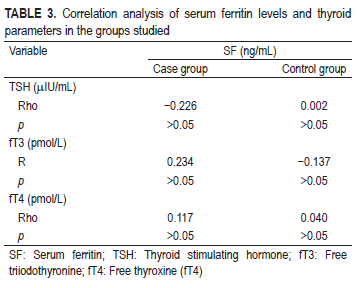Correlation of serum ferritin and thyroid hormone levels: A matched case–control study
DOI:
https://doi.org/10.17532/jhsci.2023.2611Keywords:
hypothyroid, serum ferritin, thyroid stimulating hormone, triiodothyronine, thyroxineAbstract
Introduction: Hypothyroidism is a common disorder of the endocrine system caused by insufficient biologically active hormones at the tissue level or the inability of the tissue to utilize thyroid hormones. Iron plays a crucial role in the synthesis and metabolism of thyroid hormones, and it is stored in the body as ferritin. We aimed to evaluate the correlation between serum ferritin (SF) levels and thyroid hormone panel levels in both hypothyroid and euthyroid subjects.
Methods: In 2022, a matched case–control study was conducted. The study involved participants with hypothyroidism and a control group (n = 53). The levels of thyroid-stimulating hormone (TSH), free triiodothyronine (fT3), free thyroxine (fT4), and SF were measured using the chemiluminescence immunoassay on a Mindray Cl 900-i analyzer (Shenzhen Mindray Bio-Medical Electronics Co., China).
Results: The hypothyroid group had TSH levels that were significantly higher (10.76 [8.54-18.76] vs. 1.76 [1.26-2.58]; p < 0.001) and SF concentrations that were significantly lower (39.08 [21.15-45.70] vs. 54.09 [41.41-71.82]; p < 0.001) compared to the control group. In both male and female subjects of the hypothyroid group, a strong negative correlation was found between SF concentration and TSH levels ([Rho = −0.855,p < 0.01]; [Rho = −0.747; p < 0.01]). In female subjects of the hypothyroid group, a weak positive correlation was found between SF concentration and fT3 (Rho = 0.488; p < 0.05). In the euthyroid group, a correlation of the same strength and direction was found for fT4 (Rho = 0.366; p < 0.05).
Conclusion: Research results indicate a correlation between lower SF concentrations and hypothyroidism, which is of particular importance for understanding the etiopathogenesis, diagnosis, monitoring, and treatment modalities of patients with hypothyroidism.
Downloads

Downloads
Published
License
Copyright (c) 2024 Lejla Čano Dedić, Emsel Papić, Arzija Pašalić, Dalila Smajlović, Sabina Šečić – Selimović, Sabina Šegalo

This work is licensed under a Creative Commons Attribution 4.0 International License.










